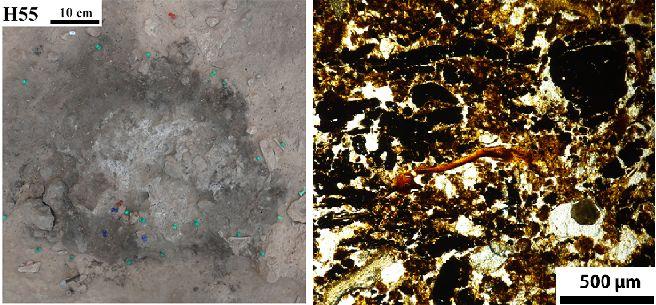Modern analysis of ancient hearths reveals Neanderthal settlement patterns
Microscopic and molecular evidence at paleolithic hearth sites helps uncover Neanderthal mobility habits

Ancient fire remains provide evidence of Neanderthal group mobility and settlement patterns and indicate specific occupation episodes, according to a new study published in PLOS ONE on April 24, 2019 by Lucia Leierer and colleagues from Universidad de La Laguna, Spain.
Most paleolithic household activities are thought to have taken place around hearths or fires. The author of the present study chose to examine the Middle Paleolithic site El Salt in Spain, which contains eleven well-preserved and overlapping open-air hearth structures. It was previously unclear whether these hearths were formed during successive short-term site occupations or fewer, longer term occupations. The authors examined the micromorphology of the different layers within the hearth structures to assess occupation timings within the study unit and conducted both a lipid biomarker analysis and isotope analysis to gain information about potential food and fuel.
The results of the analyses show stratified hearths built on multiple different topsoils over different periods of time. The burned organic matter present at the El Salt hearths is rich in herbivore excrement and flowering plant residues. The presence of flint and bone shards, as well as conifer wood charcoal collected from trees not present at the site, provide evidence of limited activity at the site. The authors suggest these data indicate at least four successive short-term Neanderthal occupations separated by relatively long periods of time, potentially based around the seasons.
The authors suggest their molecular and micromorphological methods would work well at similar paleolithic sites where fires were built. Their findings provide evidence for successive short-term Neanderthal occupations at this site, and could inform our understanding of Neanderthal group mobility and settlement more generally.
Leierer adds: “Micromorphology combined with lipid biomarker analysis is a powerful approach to investigate anthropogenic combustion-related archaeological contexts from a microstratigraphic perspective which can contribute valuable information on the timing and intensity of Neanderthal occupations as well as the natural setting of the site. These are key factors of group mobility and settlement patterns.”
###
Citation: Leierer L, Jambrina-Enríquez M, Herrera-Herrera AV, Connolly R, Hernández CM, Galván B, et al. (2019) Insights into the timing, intensity and natural setting of Neanderthal occupation from the geoarchaeological study of combustion structures: A micromorphological and biomarker investigation of El Salt, unit Xb, Alcoy, Spain. PLoS ONE 14(4): e0214955. https:/
Funding: This research was supported by the ERC Consolidator Grant project PALEOCHAR – 648871 https:/
Competing Interests: The authors have declared that no competing interests exist.
Press release from the Public Library of Science (PLOS)



